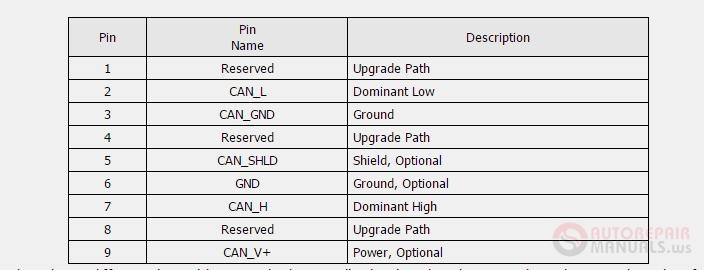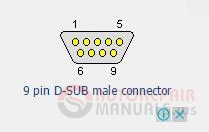- Gallons
- 403,297
SAE J1939, CAN-CIA standard interface pinout
Download Now
SAE J1939, CAN-CIA standard interface pinout
Controller Area Network (CAN) is a broadcast, differential serial bus standard, originally developed in the 1980s by Robert Bosch GmbH, for connecting electronic control units (ECUs). CAN was specifically designed to be robust in electromagnetically noisy environments and can utilize a differential balanced line like RS-485. It can be even more robust against noise if twisted pair wire is used. Although initially created for automotive purposes (as a vehicle bus), nowadays it is used in many embedded control applications (e.g., industrial) that may be subject to noise.
Bit rates up to 1 Mbit/s are possible at network lengths below 40 m. Decreasing the bit rate allows longer network distances (e.g. 125 kbit/s at 500 m).
The CAN data link layer protocol is standardized in ISO 11898-1 (2003). This standard describes mainly the data link layer, composed of the Logical Link Control (LLC) sublayer and the Media Access Control (MAC) sublayer and some aspects of the physical layer of the OSI Reference Model. All the other protocol layers are left to the network designer's choice.
SAE J1939 defines five layers in the 7-layer OSI network model, and this includes the CAN 2.0b specification (using only the 29-bit extended identifier) for the physical and data-link layers. The session and presentation layers are not part of the specification.
Originally, CAN was not mentioned in J1939, which covered cars and tractor-trailer rigs, and with some dual and triple use 8-bit addresses assigned by the SAE J1939 board. CAN was not originally free, but its instruction set did fit in the custom instruction format of J1939. This was true as of the year 2000. Since then, CAN has been included, the chipset for J1939 has been clocked faster, and 16-bit addresses (PGN) have replaced 8-bit addresses.


Controller Area Network (CAN) is a broadcast, differential serial bus standard, originally developed in the 1980s by Robert Bosch GmbH, for connecting electronic control units (ECUs). CAN was specifically designed to be robust in electromagnetically noisy environments and can utilize a differential balanced line like RS-485. It can be even more robust against noise if twisted pair wire is used. Although initially created for automotive purposes (as a vehicle bus), nowadays it is used in many embedded control applications (e.g., industrial) that may be subject to noise.
Bit rates up to 1 Mbit/s are possible at network lengths below 40 m. Decreasing the bit rate allows longer network distances (e.g. 125 kbit/s at 500 m).
The CAN data link layer protocol is standardized in ISO 11898-1 (2003). This standard describes mainly the data link layer, composed of the Logical Link Control (LLC) sublayer and the Media Access Control (MAC) sublayer and some aspects of the physical layer of the OSI Reference Model. All the other protocol layers are left to the network designer's choice.
SAE J1939 defines five layers in the 7-layer OSI network model, and this includes the CAN 2.0b specification (using only the 29-bit extended identifier) for the physical and data-link layers. The session and presentation layers are not part of the specification.
Originally, CAN was not mentioned in J1939, which covered cars and tractor-trailer rigs, and with some dual and triple use 8-bit addresses assigned by the SAE J1939 board. CAN was not originally free, but its instruction set did fit in the custom instruction format of J1939. This was true as of the year 2000. Since then, CAN has been included, the chipset for J1939 has been clocked faster, and 16-bit addresses (PGN) have replaced 8-bit addresses.


More the random threads same category:
- Radio Code Calculators, Readers, Serials, Code Seekers Collection
- Database Pin Out ECU 2015
- Fiat OBD II diagnostic interface pinout
- ATSG Automatic Transmission Service Group 2012
- BMW OBD-II diagnostic interface pinout
- Audi OBD-II diagnostic interface pinout
- Citroen OBD-2 diagnostic pinout
- SAE J1939 9 pin deutsch connector and DB9 Serial adapter pinout
- VAG 01.04.2014 - (All Engine Codes + All Gearbox Codes)
- BMW OBD II vehicle diagnostic connector pinout
- OBD-2 ISO-9141-2 (ISO 14230-4, KWP2000) serial cables schematics pinout
- Mercedes, Setra Fault Codes
- ORIGINAL File ECU Database
- Key Programming and Service Indicators 2009
- BMW old 15 pin diagnostic interface connector pinout
